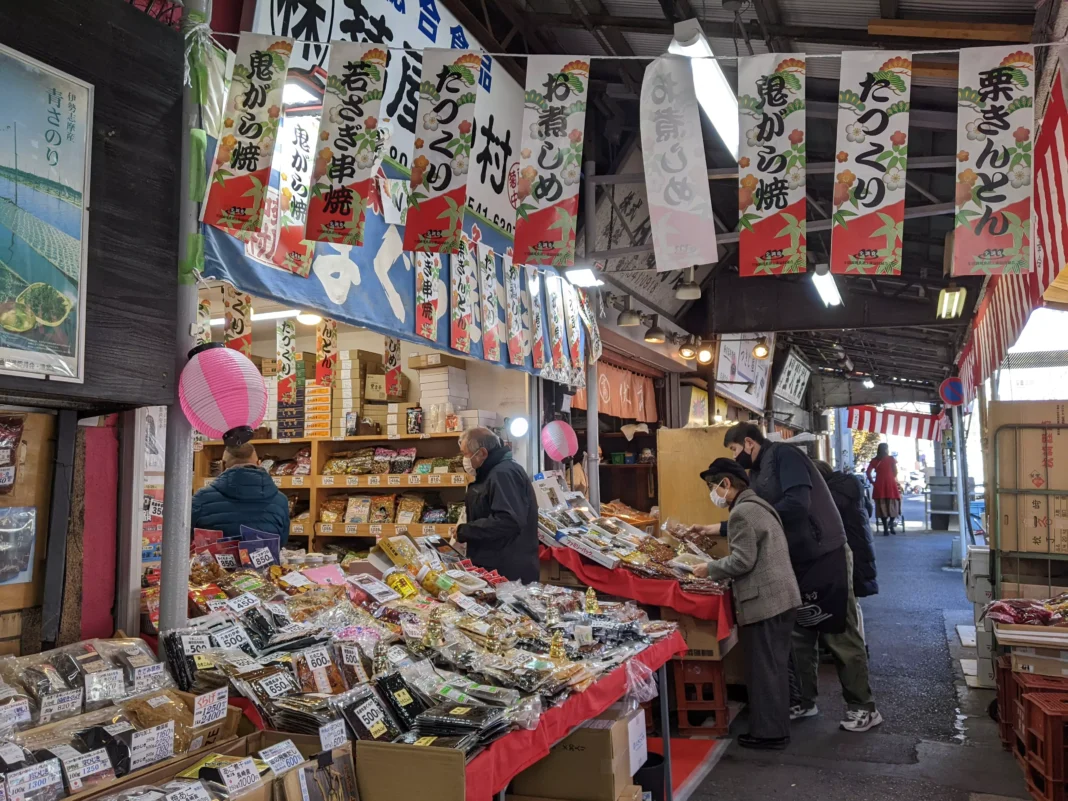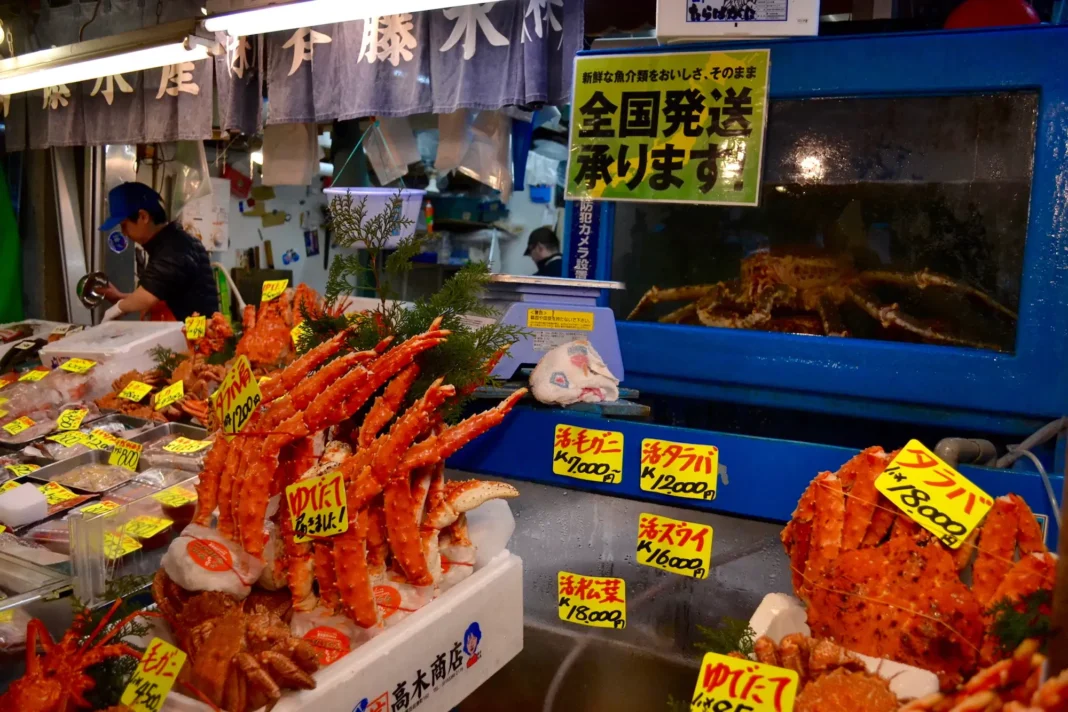A Deep Dive into Tokyo’s Iconic Fish Market
The Tsukiji Fish Market, a name synonymous with fresh seafood and culinary delights, has been a cornerstone of Tokyo’s food scene for decades. While the inner wholesale market relocated to Toyosu in 2018, the outer market remains a vibrant hub, attracting locals and tourists alike. This comprehensive guide will navigate you through the history, the must-sees, and the hidden gems of this iconic market, ensuring an unforgettable experience for every visitor.
The History of Tsukiji Fish Market
Established in 1935, Tsukiji Fish Market quickly rose to prominence as the largest wholesale fish market in the world. For over 80 years, it served as the epicenter of Tokyo’s seafood trade, handling thousands of tons of marine products daily. The market’s lively atmosphere, characterized by early morning auctions and bustling stalls, drew in crowds eager to witness the spectacle and savor the freshest catches.
Though the wholesale operations have shifted to Toyosu, the outer market continues to thrive. It retains its historic charm, offering a glimpse into the market’s legacy while serving up a delectable array of seafood and local delicacies.
Exploring the Tsukiji Outer Market
The Tsukiji Outer Market is a sensory feast, a labyrinth of narrow alleys brimming with stalls overflowing with fresh seafood, produce, kitchenware, and souvenirs. Here’s a glimpse of what awaits you:
- Seafood Galore: From glistening tuna and vibrant salmon to bizarre sea urchins and seasonal catches, the variety is astounding.
- Street Food Delights: Indulge in freshly grilled seafood skewers, steaming bowls of ramen, and the market’s claim to fame – melt-in-your-mouth sushi.
- Local Treasures: Discover unique kitchen knives, handcrafted ceramics, and traditional Japanese ingredients like dried seaweed and pickled vegetables.
- Hidden Gems: Venture beyond the main thoroughfares to uncover family-run shops, tiny eateries, and local artisans showcasing their crafts.
Address: 4-16-2 Tsukiji, Chuo City, Tokyo 104-0045, Japan Hours: Most shops open between 5:00 AM and 2:00 PM, but hours vary by individual vendors. Contact: While there’s no central contact number, individual shops have their own contact information. Website: [Insert official website link if available]
Must-Try Foods at Tsukiji Fish Market
No visit to Tsukiji is complete without indulging in its culinary offerings. Here are some must-tries:
- Sushi: Tsukiji sets the stage for the freshest sushi experience. Numerous sushi bars offer an array of options, from classic nigiri to elaborate sets.
- Kaisendon: This seafood rice bowl is a visual and culinary delight, featuring a colorful assortment of fresh sashimi over a bed of rice.
- Tamagoyaki: This sweet omelet, often served on a stick, is a popular breakfast item and a testament to the market’s culinary diversity.
- Seafood Skewers: Grilled to perfection, these skewers offer a quick and delicious way to sample the market’s fresh catches.
- Ramen: Warm up with a comforting bowl of ramen, with broths and toppings varying from shop to shop.
Tip: Arrive early to avoid the crowds and secure a spot at popular eateries. Many stalls offer samples, allowing you to explore different flavors before committing to a dish.
Navigating Tsukiji Fish Market
While the outer market is relatively compact, navigating its maze-like alleys can be overwhelming. Here are some tips:
- Start Early: Beat the crowds and witness the market at its most energetic by arriving early in the morning.
- Wear Comfortable Shoes: You’ll be doing a lot of walking, so comfortable footwear is essential.
- Bring Cash: While some vendors accept credit cards, cash is still king in many stalls.
- Respect the Etiquette: Avoid blocking pathways, refrain from loud conversations, and be mindful of photography restrictions in certain areas.
- Embrace the Experience: Get lost in the vibrant atmosphere, interact with the friendly vendors, and savor the unique energy of the market.
Beyond the Market: Exploring Nearby Attractions
Tsukiji’s central location makes it an ideal starting point for exploring other Tokyo attractions. Here are some nearby gems:
- Tsukiji Hongwanji Temple: This magnificent Buddhist temple, with its unique Indian-inspired architecture, is a serene oasis amidst the bustling market.
- Ginza District: A short walk from Tsukiji, Ginza is Tokyo’s upscale shopping district, home to high-end boutiques, art galleries, and elegant restaurants.
- Hamarikyu Gardens: Escape the city buzz in this tranquil Edo-era garden, featuring a picturesque pond, tea houses, and seasonal blooms.
- Kabuki-za Theatre: Immerse yourself in traditional Japanese culture with a captivating Kabuki performance at this renowned theater.
Practical Tips for Your Tsukiji Adventure
- Transportation: Tsukiji is easily accessible by subway. The nearest stations are Tsukiji Station (Hibiya Line) and Tsukijishijo Station (Oedo Line).
- Currency Exchange: While ATMs are available, it’s advisable to exchange currency beforehand for smaller purchases at the market.
- Language: While English is spoken in some tourist areas, learning a few basic Japanese phrases can enhance your experience and interactions with locals.
- Cultural Etiquette: Bowing is a common form of greeting and showing respect. Remove your shoes before entering temples and traditional establishments.
Transliteration Guide for Essential Japanese Phrases
Greetings
- Good morning: Ohayo Gozaimasu (Ohio Gozaimasu)
- Good afternoon: Konnichiwa (Konnichiwa)
- Good evening: Konbanwa (Konbanwa)
- Thank you: Arigato Gozaimasu (Arigato Gozaimasu)
- Excuse me: Sumimasen (Sumimasen)
Directions
- Where is [place]?: [Place] wa doko desu ka? ([Place] wa doko desu ka?)
- To the right: Migi e (Migi e)
- To the left: Hidari e (Hidari e)
- Straight ahead: Massugu (Massugu)
Dining
- I would like to order: Chumon o onegai shimasu (Chumon o onegai shimasu)
- Delicious: Oishii desu (Oishii desu)
- Water, please: Ohiya o kudasai (Ohiya o kudasai)
- Check, please: Okaikei o kudasai (Okaikei o kudasai)
Emergencies
- Help!: Tasukete! (Tasukete!)
- I need a doctor: Isha o yonde kudasai (Isha o yonde kudasai)
- Police: Keisatsu (Keisatsu)
Note: Japanese pronunciation is generally straightforward, with vowels pronounced similarly to Spanish. Be mindful of long vowels, indicated by a line above the vowel, as they are held for a longer duration.
Real-Life Stories: Tsukiji Experiences
- The Sushi Enthusiast: “I’ve always been a sushi lover, but Tsukiji took my appreciation to a whole new level. The freshness and quality of the fish were unparalleled. Watching the chefs expertly prepare each piece was a mesmerizing experience.” – John S.
- The Cultural Explorer: “Tsukiji was more than just a food market; it was a cultural immersion. The energy, the sights, the sounds – it was an assault on the senses in the best way possible. I left with a deeper understanding of Japanese culinary traditions.” – Maria G.
- The Early Bird: “Waking up before dawn was worth it! Witnessing the tuna auction was a thrilling experience. The sheer size and quality of the fish were awe-inspiring. And the breakfast sushi afterward? Simply divine!” – David L.
Tsukiji Fish Market: A Must-Visit Destination
Tsukiji Fish Market, even after its transformation, remains a captivating destination. It’s a place where history, culture, and culinary artistry converge, offering a unique and unforgettable experience for every visitor. Whether you’re a seafood aficionado, a culture enthusiast, or simply seeking an authentic Tokyo adventure, Tsukiji will not disappoint.
Tip: Consider joining a guided tour to gain deeper insights into the market’s history and navigate its hidden corners with ease.
Planning Your Trip to Tsukiji Fish Market
Ready to embark on your Tsukiji adventure? The Tsukiji Fish Market, renowned for its fresh seafood and bustling atmosphere, is a must-visit destination for food enthusiasts and travelers alike. Here’s a quick guide to help you plan your visit:
Key Highlights of Tsukiji
- Outer Market: Explore an array of seafood stalls, fresh produce, and specialty shops offering everything from sushi knives to Japanese spices.
- Restaurants: Enjoy some of the freshest sushi and sashimi at the market’s many eateries.
- Cultural Experience: Witness the vibrant energy of a traditional Japanese marketplace and interact with local vendors.
Tips for Visiting
- Arrive Early: The market comes alive in the early morning. For the best experience, plan to arrive before 9 AM.
- Bring Cash: Many vendors only accept cash, so be prepared with yen.
- Wear Comfortable Shoes: You’ll be walking a lot, so wear sturdy and comfortable footwear.
- Respect the Vendors: The market is a workspace for many. Be mindful of their operations and follow local etiquette.
Helpful Resources
To make the most of your trip, explore these resources for additional guidance:
Plan your visit to Tsukiji Fish Market and immerse yourself in one of Tokyo’s most iconic cultural and culinary experiences. Whether you’re a food lover, a culture enthusiast, or just curious, Tsukiji promises an unforgettable adventure!
Remember: Tsukiji is a dynamic and ever-evolving destination. Embrace the unexpected, be open to new experiences, and savor every moment in this vibrant seafood paradise.











